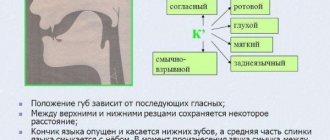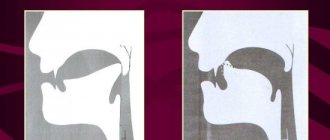Hello, dear readers! In the last article, I talked about preparing the organs of articulation for producing the sound sh. Continuing to develop the topic, I will tell you what ways there are to produce sh. The articulatory structure of Sh is such that the wide tongue should be located and held behind the upper teeth. Both of these conditions require special training. As a rule, during the initial examination it turns out that the child has a narrow tongue and he cannot lift it up at all or has great difficulty.
Setting whistling sounds with probes No. 1, No. 2 and No. 4
For lateral and nasal pronunciation of whistling sounds, when it is not possible to obtain a groove along the midline of the tongue, probe No. 1 is used.
First, using a probe, a groove is formed with the tongue protruding from the mouth. The child is asked to blow into the groove formed in the tongue and then this skill is reinforced, gradually eliminating mechanical assistance.
To make the sound “C”
The speech therapist invites the child, without sticking out his tongue, to open his mouth and smile. Then he places the probe on the front of the tongue in the middle, holding the tip of the tongue with the base of the loop of the probe against the lower teeth. In this position, the child is asked to blow on the tip of his tongue. At the same time, the speech therapist lightly presses the probe on the tongue, forming a groove for escaping air and achieving the desired acoustic effect. After a series of training in pronouncing the sound “C” with probe No. 1, the child is able to reproduce the necessary articulatory pattern and correctly pronounce the sound without mechanical assistance. Then the sound is automated based on the speech material selected by the speech therapist.
The sound “3” is placed in a similar way, but with the involvement of the vocal cords.
To eliminate interdental and subdental sigmatism, especially complicated by malocclusion, probes No. 2 and No. 4 are used. The sound is made from defective pronunciation. The child is asked to pronounce the sound s-s-s for a long time...
At this time, the speech therapist, pressing on the tip of the tongue with the loop of probe No. 2 or probe No. 4 placed across the mouth in front of the lower fangs, slightly moves the tongue away from the lower teeth into the depths of the mouth. A gap is formed, necessary to reproduce the whistling noise. Gradually, the mechanical assistance is eliminated and the child can independently pronounce the sound.
Sound "Ts"
can be obtained using probes No. 1 and No. 2 in two ways.
The child is asked to pronounce the sound combinations ts-ts-ts...
Simultaneously with the pronunciation, the speech therapist holds the tip of the tongue
with probe No. 1
or
No. 2
at the lower incisors (according to F.F. Pay).
Pressing the tip of the tongue against the lower teeth, the child is asked to pronounce the sound s-s-s for a long time with a soft attack...
At the same time, the speech therapist presses the tip of the tongue with probe No. 1 or No. 2, slightly moving it deeper into the mouth (according to O.V. Pravdina). By controlling the probe, the speech therapist achieves clear pronunciation of the sound.
Soft sounds are set from hard base sounds. Delivered using probes No. 1, No. 2 and No. 4
whistling sounds are automated and differentiated.
Staging from A, E, Y
If there is nothing in the asset, you can try to put it from the vowels, A, E, Y. Ask to pronounce them and use the probe to lift your tongue up. In general, Ш is placed well in the reverse syllables ASH - OSH - USH - YSH - ESH. Especially with severe speech disorders, when the baby does not speak at all, this is an option. In addition, we must not forget that with dysarthria, as a rule, C is placed last. Because tremor and hyperkinesis of the tongue make it impossible to achieve purity of sound without preliminary treatment with massage.
Setting hissing sounds with probes No. 3 and No. 5
To produce hissing sounds, use probe No. 5. The production begins with the sound “Ш”,
which is basic for the sounds of this phonetic group.
If the child pronounces the sound “C” correctly, the speech therapist asks him to open his mouth and inserts probe No. 5
wide end part under the tongue.
Then the child is asked to bring his teeth together and pronounce the sound s-s-s...
At the moment of pronouncing the sound with the help of a probe, the tip of the tongue is moved to the upper position.
By controlling the probe, the speech therapist regulates the degree of elevation of the tongue, achieving a clear hiss. The child's attention is fixed on the position of the tongue. However, until the new articulation is established, you cannot tell the child what sound he is making. Gradually, the baby gets used to the new articulation and pronounces the sound “Ш”
independently and for a long time.
Only after this inform the child that he has learned to correctly pronounce the sound “Ш”
and automate this phoneme in syllables and words.
The sound “Zh” is placed from the sound “Sh”
by turning on the voice or using
probe No. 5
in the same way, but from the sound “3”.
If the child pronounces the sound “R” correctly ,
you can put the sounds
“SH”
and
“Zh”
from this sound.
The child is asked to pronounce the sound “R” for a long time.
At the moment the sound is pronounced, the speech therapist brings
probe No. 5
to the lower surface of the front part of the tongue and inhibits its vibration.
When pronouncing the sound “R” in a whisper, the sound “Sh” is heard,
when pronouncing it loudly,
“Zh”.
Sound "Ch"
can be obtained from the soft sound
“TH”
by asking the child to pronounce the reverse syllable at with increased exhalation
.
At the moment of pronunciation, the speech therapist, using probe No. 5, slightly lifts and moves the tip of the tongue slightly back, achieving the desired acoustic effect.
Like all affricates, the “Ch”
is more easily automated in reverse syllables.
To produce the sound "Ш"
The child is asked to pronounce the syllable as in a drawn-out manner several times
.
Then the speech therapist inserts probe No. 5 under the tongue and, at the moment of pronouncing the syllable, slightly lifts the tongue and moves it back a little.
Sometimes, to evoke the sound “Ш”,
it is simply enough to ask the child to pronounce the sound
“Ч” for a long time.
Probe No. 3 is also designed to produce hissing sounds in some cases when the child has a fairly massive, large tongue. Producing sounds with this probe greatly facilitates the work of a speech therapist. By controlling the probe, the speech therapist lifts the child’s tongue and quickly develops the articulatory patterns necessary for pronouncing hissing sounds.
The techniques for producing sounds with probe No. 3 are similar to those performed with probe No. 5.
You can work either with the end part of the probe, changing the angle of its inclination, or with its transverse part with wavy teeth.
Then the hissing sounds produced using probe No. 5 or probe No. 3 are automated and differentiated.
Production from R
You can also set from P if the sound is well automated. When pronouncing a sound, you need to hold the probe slightly under the tip so that it does not vibrate. Or ask the child to say RRRSH. It’s good to first do the dynamic exercise “fungus - sail”, then suck your tongue to the palate, then release the middle part in the shape of a cup. It is advisable to pronounce the sound R not voiced, if in the end you want to get a Ш, a voiced sound can result in a J or a H, which is also, in general, not bad.
Reviews about the procedure “Installation of a gastric tube”
We collect real reviews from both regular clients and clients who order the procedure for the first time.
You can read the rest of the reviews on the “Reviews” page. Mom has cancer, so she can’t eat on her own. The doctor prescribed enteral nutrition. I ordered a service from the clinic. I was very pleased with the competence of the staff.
Menshova Elena Vasilievna
After a stroke, my father could not swallow food normally. The doctor recommended inserting a nasagastric tube. We ordered a service from Medpomoshch 24. The nurse did everything carefully and efficiently. Dad is already much better. Thank you.
Kryukov Egor Petrovich
My mother has Alzheimer's disease, so it became necessary to install a gastric tube.
An employee from Medpomoshch 24 not only performed the procedure efficiently, but also gave a lot of good advice about feeding. Karpacheva Anastasia Vladimirovna
How is a nasogastric tube placed?
This manipulation is performed by the attending physician or a doctor in the endoscopy department when there is a need for endoscopic control. The probe, under local anesthesia, is inserted through the nasal passage into the pharynx and slowly moves into the stomach, while the patient helps the doctor by making swallowing movements. When setting, there is no need to resist, as this brings even more discomfort.
Frequently asked questions from our patients
Our clinic specialists have extensive experience in performing this procedure. Therefore, the installation will be safe, which reduces the risk of negative consequences to a minimum.
We will select effective analgesics for you, which will reduce discomfort.
The device is installed for up to 30 days. But we recommend using it no longer than 2.5 weeks.
Yes. The technique for inserting a probe into children is practically no different from installing a system for adults.
Feeding process
The procedure is carried out according to the following algorithm:
- The patient's body is given a semi-sitting position;
- The outer part of the probe is lowered below the patient’s neck and compressed with a special clamp;
- The funnel is connected to the syringe, it rises to a level of up to half a meter above the stomach, after which the clamp is removed.
- Food is served slowly, with virtually no pressure; no more than 150 ml should be administered in 5-6 minutes.
- After finishing feeding, it is necessary to rinse the area by applying 30-50 ml of water through it.
- Next, the tube is clamped again, lowered, and the inlet is closed with a plug.
Tube is a modern and effective way of feeding seriously ill patients. It has a lot of advantages. Unlike intravenous nutrition, in this case atrophy of the gastric mucosa is not allowed, the gastrointestinal tract system remains in working order. The enteral system can be used for a long time. The probe is installed for three weeks. The administration procedure must be carried out by a doctor, and he must also give his recommendations regarding the feeding procedure and diet.
Main indications for use
Eating through a tube is carried out in cases where the patient is not able to do this on his own. His swallowing function is depressed, there is no clear consciousness, or there are serious lesions in the throat and oral cavity. The probe is most often installed in the following cases:
- After a stroke, if we are talking about damage to the areas of the brain that control the swallowing reflex, the function may be partially or completely inhibited. A return to normal eating habits is possible after completion of rehabilitation. In case of extensive damage and advanced age of the patient, enteral nutrition can be permanent.
- For physical injuries - head injuries, severe swelling of the tongue and larynx.
- If the patient is in a coma or unconscious.
- With the development of psychological disorders, when the patient refuses to eat.
- Neurological diseases (multiple sclerosis, Parkinson's, Alzheimer's), accompanied by corresponding disorders.
- During surgical interventions in the gastrointestinal tract.
Enteral feeding is prescribed in cases where the traditional form of eating is impossible or difficult, if the patient may choke, or if incoming food may infect damaged tissues and organs.
Preparing for the procedure.
It is necessary for the doctor to establish a trusting relationship with the patient or his relatives.
The doctor must tell the patient the purpose of the upcoming procedure and familiarize him with what food he will be given. The doctor should also tell you about the stages of the upcoming procedure. The room should be ventilated in advance. The next stage of preparation for inserting the probe is measuring the distance from the throat to the stomach. To do this, the patient must sit up straight. Then the doctor should take a measurement. There is an alternative way to calculate the distance to the stomach; to do this, you need to subtract 100 cm from the person’s height. In order for the nasogastric tube to easily enter the stomach, it is recommended to moisten it in the Furacilin solution. The solution is diluted in a ratio of 1 to 2000. The nasogastric tube is wetted to the marked mark. Next, you should put the patient on the couch. He lies down on his back. A pillow is placed under the head. It is necessary to make sure that the head is slightly tilted. This position will ensure free insertion of the probe into the nasopharynx. A napkin is placed on the patient's chest. The doctor must carry out this procedure wearing gloves.
Nutritional Features
If the patient feels normal after installation, you can start eating immediately. All dishes served must have only a liquid consistency. They should be warm, that is, temperatures of 37-39 degrees. Hot foods may cause burns.
It is necessary to increase the volume of servings gradually; the first two or three times it should not be more than 100 ml. In the future it can be increased to 300 ml. The following products are best suited for enteral nutrition:
- Kefir;
- Fish, meat, vegetable broths;
- Thoroughly mashed puree;
- Rare porridges, especially semolina;
- Special mixtures.
Ready-made dry mixtures can be used as a basis for nutrition or in addition to the diet. They are rich in protein, which bedridden patients often lack.
The number of meals should be no more than 5, but not less than 3. A sterile syringe must be used for administration each time. The nursing service specialists strictly follow all the rules for feeding through zones and carefully monitor the hygiene of the entire process.







